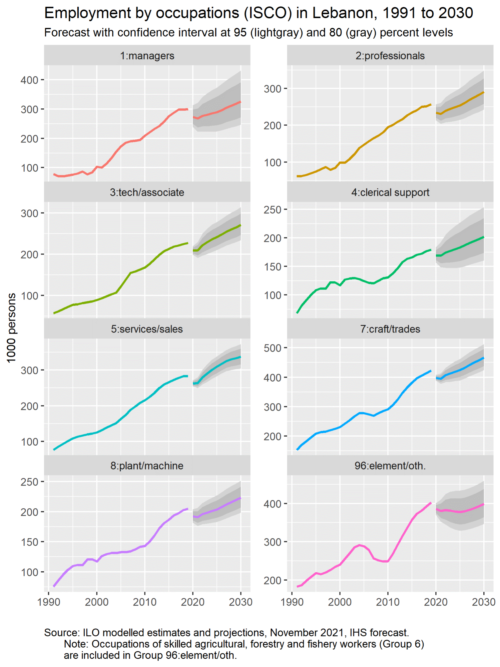Future development of employment in Lebanon
The Institute for Advanced Studies (IHS) forecasts a slowdown of the expansion in employment in Lebanon. Between 2023 to 2030 the average yearly growth may amount to only 1.6 percent, compared to 3.3 percent observed between 2000 and 2019. The downward risks of our forecast are the impact of the economic consequences of the Russo-Ukrainian war/conflict and a renewed COVID-19 outbreak. An upward risk exists if the government successfully implements the comprehensive macroeconomic stabilization and reform program. Our forecast is based on a quantitative occupational forecasting model which is designed for the Lebanon labour market and has been developed within the CONECTE project.
Currently the Lebanese economy is in a severe economic and financial crisis with a deep contraction in economic activity associated with a very strong price pressure and high unemployment. We expect that the economy will recover from the severe financial crisis that bottomed in 2021. Even in the years to come, however, the economy might show only modest growth and will develop well below the average growth trend of the past 20 years. One of the reasons is a slowdown in the world economy, particularly caused by persistent consumer price inflation and rising interest rates. In addition, in the second half of this decade, demand from MENA (Middle East and North African) countries will slow as the global phase-out of fossil fuels will begin to bite. At the national level, a major problem is the activity slowdown in the construction industry which is a major employer in the Lebanese economy.
Economic activity and structure together with technological progress have an impact on occupations and skills needed. We find that in the years ahead the demand for persons with occupations requiring advanced skills, such as managers, professionals, technicians and associate professionals will increase by an average yearly growth rate of 2.4 percent. In contrast, with the exception of services and sales occupations, the demand for persons with occupations requiring intermediate and low skills will grow at a much slower pace. The uncertainty of our forecast is the lowest for the group of services and sales occupations. The forecasts with confidence interval of all major occupational groups are shown in Figure: “Employment by occupations (ISCO) in Lebanon, 1991 to 2030”.
Authors: Robert Kunst and Edith Skriner, Institute for Advanced Studies, Vienna, Austria.
